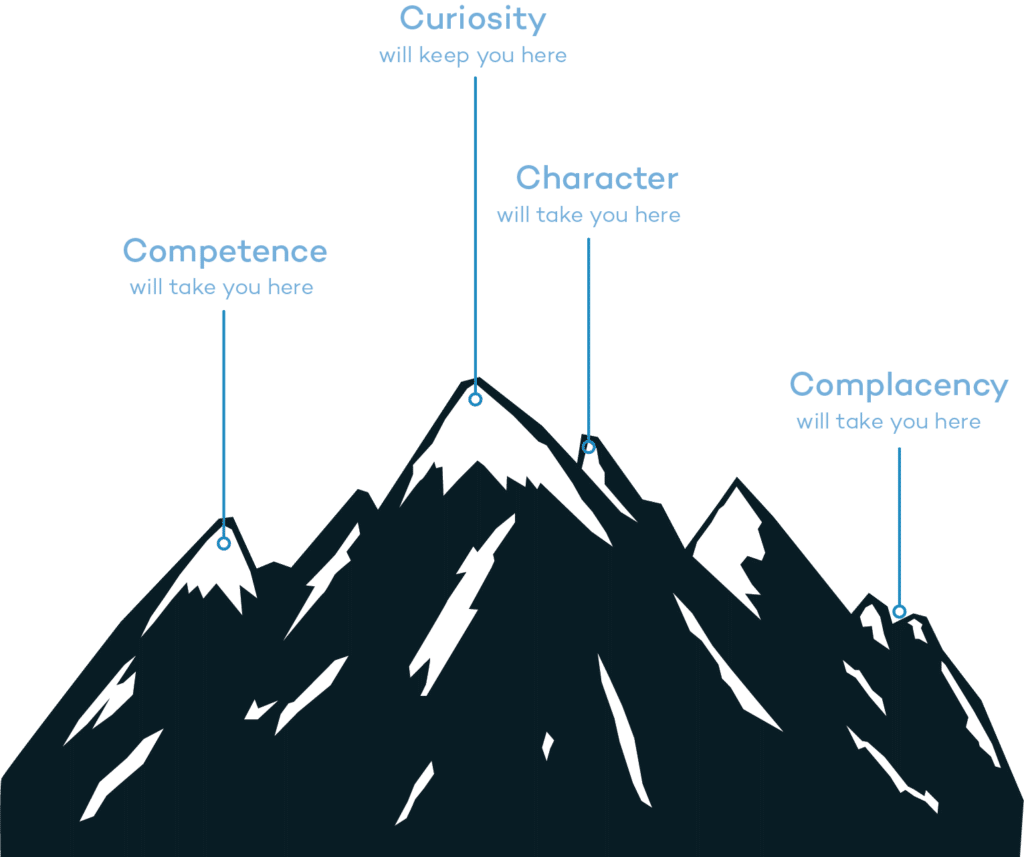
Introduction
In today’s fast-evolving workplace, “power skills” have emerged as essential competencies that drive personal and professional growth. Often synonymous with “soft skills,” these abilities encompass communication, emotional intelligence, adaptability, resilience, and problem-solving—skills that go beyond technical expertise. Intentional development of power skills fosters self-awareness and accountability, both of which are crucial to reaching one’s goals.
Recent studies underscore the importance of cultivating these skills to enhance personal accountability, which can significantly impact performance and overall success. A 2023 LinkedIn Workplace Learning Report highlighted that 94% of employees feel power skills are as critical as technical skills in career advancement. The report emphasises a shift towards valuing these skills for fostering resilience and self-accountability, both essential in setting and achieving goals. This insight is further supported by a meta-analysis published by McKinsey in early 2023, which identified self-management as a “top-performing power skill” that fuels adaptability and resilience—qualities essential in dynamic and demanding environments.
The Link Between Power Skills and Goal Accountability
Accountability is a powerful driver of goal achievement, and power skills play a crucial role in building it. Self-awareness, for instance, allows individuals to recognise their strengths and weaknesses, set realistic goals, and hold themselves accountable when obstacles arise. A Harvard Business Review study in 2022 found that professionals who set clear, specific goals and track their progress are 40% more likely to achieve them than those who don’t. Power skills such as communication and emotional intelligence help individuals manage these goals, recognise feedback, and respond constructively.
Intentional development can be as simple as regular self-reflection, using a coach or seeking out challenging projects. Studies reveal that targeted learning, even in short increments, can boost one’s capacity for self-regulation and adaptability, with immediate benefits to personal accountability.
Fostering a Culture of Accountability Through Power Skills
Organisations also benefit when their workforce embraces power skills, as they directly impact accountability at both individual and team levels. Building a culture that prioritises these skills fosters a shared sense of purpose and accountability, amplifying collective goal achievement.
In Practice: Building Power Skills for Accountability
The journey to enhancing power skills requires commitment and a structured approach:
- Define Clear Goals: Set specific, measurable, attainable, relevant, and time-bound (SMART) goals.
- Regular Reflection: Reflect on progress regularly (or get someone to help you reflect), celebrate wins, and assess areas needing improvement.
- Develop Communication Skills: Effective communication enables clearer expectations, constructive feedback, and accountability.
- Seek Feedback and Embrace Learning: A continuous learning mindset allows individuals to adjust goals and remain accountable.
Power skills are more than soft competencies—they are actionable, measurable drivers of personal and organisational success. Intentional development of these skills not only enhances accountability but also empowers individuals to reach their goals with resilience and adaptability, shaping a future-ready workforce.
More on Soft Skills
Modern Skills for a Modern Boardroom: A New Look at Leadership
Leadership in Focus: Foundations and the Path Forward
The Evolution of Great CEO Leadership
Steering Point partners with organisations, teams, executive leaders, and performers to foster positive behavioural change resulting in sustainable high performance. We specialise in designing experiential engagement programmes that develop cognitive, behavioural, emotional, and leadership capacities.

Introduction
Setting medium- and long-term goals isn’t just an exercise in planning; it’s a strategy to tap into realising your potential. In today’s fast-paced environment, taking the time to clarify objectives for 2025 and 2026 is prudent. Understanding how setting objectives translates into a sense of purpose and flow not only boosts motivation but also ensures practical steps align with the big picture. This approach is backed by psychology, neuroscience, and examples from high-performing athletes and executives alike.
The Comfort of Clarity: Purpose Drives Flow
Studies by renowned institutions, like Stanford University, emphasise that the brain thrives with clarity and purpose. Psychologist Mihaly Csikszentmihalyi’s research on the state of “flow” reveals that people are most productive and creative when they have clear, achievable goals. This state of deep engagement, often described as “being in the zone,” results from aligning actions with a clearly defined purpose. By setting intentions for the next year or two, we create a scaffold, helping our brains stay focused even as the context changes over time.
When top athletes envision the outcome of each match and each season, they gain a mental edge. Sports psychologist and former Olympian Peter Haberl highlights that visualisation is a tool that “trains the brain to map out an ideal version of future outcomes,” making the process tangible. In business, leaders who establish vision-aligned objectives empower teams to understand not only what they are working toward but why it matters, making every step meaningful.
Planning Your Path: Breaking Down the Journey
Effective planning doesn’t just map the destination; it lays out the steps that take us there. By breaking down objectives into actionable short-term goals, the long-term vision becomes attainable. The renowned “Goal Gradient Hypothesis” by behavioural scientist Kurt Lewin reveals that motivation increases as we get closer to reaching a goal, and breaking down large objectives into smaller, more frequent wins taps into this principle. For example, in a corporate setting, dividing a two-year strategic initiative into quarterly or monthly milestones creates checkpoints that maintain momentum and accountability.
Harvard Business Review has shown that executives who set progressive, measurable steps to reach their goals report 43% higher engagement than those who don’t. Not only does this keep team members on track, but it also allows for greater flexibility to make adjustments when necessary, a crucial factor when working toward goals over an extended period. This accountability mechanism doesn’t just hold people to a plan; it empowers them to feel the impact of each effort, reinforcing the path forward.
Empowerment Through Alignment: Contributing to the Bigger Picture
Knowing that daily actions contribute to a larger objective offers a sense of accomplishment and agency, whether in personal or professional settings. Aligning individual goals with organisational objectives allows people to experience the satisfaction of working toward something meaningful, driving motivation and resilience. Research from the London School of Economics shows that employees who understand how their roles contribute to a larger mission are twice as likely to remain committed and proactive.
Top companies like Google employ the Objectives and Key Results (OKRs) framework to maintain this alignment, where quarterly objectives ladder up to larger goals. This creates a culture of accountability and direction, demonstrating how day-to-day tasks contribute to a strategic mission. When people recognize the broader impact of their contributions, they stay invested, resilient, and motivated, qualities essential for navigating both peaks and valleys in business.
Adaptability and Agility: Navigating Peaks and Troughs
In any journey, challenges and obstacles are inevitable. A well-defined plan provides a foundation, but remaining flexible allows you to adjust course as circumstances shift. Dr. Carol Dweck’s work on “growth mindset” from Stanford suggests that a flexible approach—underpinned by the belief that growth is always possible—helps individuals and teams persevere.
Setting intentions now for 2025 and 2026 may seem early but it enables a proactive response to inevitable changes rather than a reactive scramble. This agility maintains focus on the broader goal, even if the steps to reach it require adjustment.
Top-performing organisations regularly reassess their strategies, allowing them to stay relevant and resilient in a constantly evolving environment. Quarterly reviews or “check-ins” offer an opportunity to realign objectives and address unexpected challenges. This adaptability is key to maintaining momentum over time, sustaining both individual engagement and organisational progress.
Accountability Mechanisms: Staying on Track
Accountability is essential for turning intentions into outcomes. Whether through peer accountability, check-in sessions, team coaching, individual feedback or personal commitment tools, creating a support structure ensures you follow through on your goals.
In summary, planning for 2025 and 2026 now is more than an administrative task—it’s a catalyst for focus, alignment, and momentum. Setting clear objectives enables individuals and organisations to move confidently through both peaks and valleys. It builds a framework where each action, however small, feels like a part of a larger, purpose-driven journey. By setting intentions now, you’re setting yourself up for a future marked by clarity, purpose, and achievement.
Steering Point partners with organisations, teams, executive leaders, and performers to foster positive behavioural change resulting in sustainable high performance. We specialise in designing experiential engagement programmes that develop cognitive, behavioural, emotional, and leadership capacities.
More on Goal Setting
Effectively Implementing Goals
Manifestation: Life-Changing Practice or New Age Gaga?
How to Achieve Peak Performance
Rethinking the Workplace – Podcast

Introduction
Steering Point recognises that transformational change in organisations often creates significant disruption, requiring organisations to balance the drive for innovation with mechanisms that maintain stability. Stability during transformational change ensures that the workforce remains grounded, processes continue efficiently, and the overall organisational capacity is not lost in the transition. When this balance is struck, the true ability within the organisation is realised, allowing it to fully leverage its strengths and embrace the new direction.
Key elements that bring stability and enable the realisation of organisational potential include:
1. Consistent Leadership:
Stable leadership is critical during transformational change. Leaders provide the vision and reassurance needed to guide employees through uncertainty. A consistent leadership approach fosters trust, ensuring employees feel supported and secure despite the disruptions. This stability helps individuals and teams stay focused, unlocking their full potential as they transition to new ways of working.
2. Clear Communication:
Transparent, frequent, and clear communication is a stabilising force that counteracts the anxiety and confusion often associated with transformation. By ensuring that employees understand the reasons for change, the steps involved, and their role in it, organisations can reduce resistance. Clear communication aligns teams with the broader goals, enabling them to perform effectively and adapt quickly to new challenges, which maximises their abilities.
3. Structured Change Management:
A structured and methodical approach to implementing change provides a sense of control and predictability. By using frameworks like change management models (e.g., Kotter’s 8-Step Process or ADKAR), organisations can create a phased, gradual transition that minimises chaos. This structured approach allows employees to adjust in manageable increments, preventing overwhelm and helping them sustain high performance throughout the change.
4. Retention of Core Values and Culture:
Maintaining core organisational values acts as an anchor during transformation. While strategies and processes may evolve, core values like integrity, collaboration, or customer focus provide continuity, helping employees find stability in familiar norms. This adherence to cultural touchstones allows the organisation to leverage its inherent strengths, ensuring that its fundamental capabilities are not lost during change.
5. Support Systems:
Providing adequate support, such as performance programs, coaching, and resources, helps employees adapt to new responsibilities, ensuring they can apply their full skill set. Emotional support, through mentoring or well-being programmes, also plays a key role in reducing stress. When employees feel supported, they are more likely to embrace change, perform at their best, and contribute to the organisation’s success.
Conclusion
In conclusion, by integrating stability through consistent leadership, clear communication, structured implementation, strong cultural anchors, and support systems, organisations can mitigate the challenges of transformational change. This balance not only fosters resilience but also allows the organisation’s true ability to flourish, making the transformation effective and sustainable.
More on Change Management
Pioneering Change : A Case Study of Jeff Bezos Transformational Leadership at Amazon
Chameleons, Leadership and Change
Mastering Change and Complexity: Strategic Leadership in an Uncertain Business World
Embracing Ambiguity: Leadership in the Liminal Space

Introduction
In today’s rapidly evolving business landscape, the differentiators that set the most successful teams apart are often not just their operational strategies, leadership or technology. Increasingly, what defines high-performing teams is their commitment to people development coupled with a purposeful culture. These two elements create a powerful synergy that drives sustainable success, both in teams and organisations.
Mercedes F1: An Example of Unrivalled Success
A prime example of this in action is the Mercedes-AMG Petronas Formula One Team, one of the most successful teams in the history of motorsport who from 2014 to 2021, won a staggering eight constructors’ titles in a row. Under the leadership of Toto Wolff, Mercedes has not only dominated the Constructors’ and Drivers’ Championships for several consecutive years but has also become known for a culture that is deeply embedded in personal development and relentless improvement.

Mercedes has embraced a leadership model that promotes continuous development from the top down, empowerment, and accountability at every level. From their top drivers (Lewis Hamilton) to mechanics and engineers, they are all encouraged to own their personal growth and align it with the team’s goals. This investment in people, paired with a clear vision of excellence, allowed Mercedes to stay ahead in a highly competitive, fast-paced environment where small margins and performance are paramount.
Culture and Personalised Development as Critical Differentiators
Recent research from the Institute for Corporate Productivity (i4cp) has shown that high-performance organisations are 5.5 times more likely to have robust Leadership and Talent pathways in place. As Mercedes F1 demonstrates, culture is not just an intangible concept but a deliberate and structured framework that guides decision-making, behaviour, and, ultimately, performance.
Personalised development is also becoming increasingly important, particularly as workforces become more diverse, dispersed and multi-generational. Studies from the Centre for Creative Leadership (CCL), published in 2023, show that teams with strong leadership development programs outperform their peers, often driving higher engagement and retention rates. Businesses that offer tailored development programs—just like the performance coaching and support systems seen in the Mercedes F1 team—create environments where individuals thrive and collectively drive the organisation to greater heights.
Future Trends and Societal Needs
As work becomes more digital and flexible, a shift toward people-centric development is no longer a “nice to have” but a necessity. The World Economic Forum’s Future of Jobs Report published in May 2023, highlights that the top skills for future workforces will be centred around leadership, emotional intelligence, and adaptability—core components of strong cultural and development programs. Forward-thinking companies are integrating well-being, mental health, and leadership coaching into their cultures, recognising that when employees feel supported and developed, they perform better.
Simple Framework for Organisations
To foster a culture of continuous people development, organisations should consider the following elements involved in our Steering Point framework:
- Individual Growth Plans (IGPs): Tailored development programmes that align individual growth with company goals
- Leadership Development: Ongoing training for leadership teams to model and cultivate the desired culture
- Regular Feedback Loops: Structured feedback that encourages both personal and collective improvement
- Recognition Systems: Acknowledge not just performance, but also learning, collaboration, and adaptability
Conclusion
In a world where high performance is often synonymous with innovation and agility, companies that prioritise the development of their people and foster a strong culture will set themselves apart. As Mercedes F1 has demonstrated, investing in people and cultivating a growth mindset across all levels not only yields impressive results but also builds a lasting legacy of excellence.
However, many organisations and leaders still overlook the importance of consistent and intentional people development. Cultivating high performance within a team is much like tending to a garden. Just as a gardener regularly weeds, water, and nurture their plants to encourage healthy growth, leaders must consistently invest in their teams to foster an environment where potential has no choice but to flourish. In the end, the most sustainable success stems from a workforce that feels valued, engaged, and equipped to meet future challenges.
More on Growth Mindset
Building A Resilient Workforce : The Power of A Growth Mindset
High Standards and Low Expectations: a Blueprint for Wellbeing
Maximising human potential with Enda McNulty – Podcast
How to Achieve Peak Performance

Introduction
Robert Kegan and Lisa Lahey are renowned developmental psychologists and professors at Harvard. They focus on adult development, organisational behaviour, and leadership combining that result in optimal and sustainable performance. In their book “An Everyone Culture,” they explore the concept of Deliberately Developmental Organisations (DDOs), advocating for workplaces that prioritise personal growth and continuous learning as key to success.
Fostering a culture of growth
The authors emphasise that many organisations are relentless at process improvement but not as many are relentless at continuous people development. They argue that fostering a culture of personal and professional growth is the key to sustained success and long-term innovation. The concept of DDOs, where the primary focus is on the constant development of individuals within the company, leads to greater resilience, adaptability, and performance across the entire organisation.
Continuous people development
Process improvements, while valuable, are often finite and focused on efficiency and productivity gains. They can streamline operations and reduce costs but don’t necessarily cultivate the creativity, problem-solving abilities, or emotional intelligence needed to navigate increasingly complex and unpredictable business landscapes.
Continuous people development, on the other hand, builds an organisation’s capacity for learning, innovation, and transformation, allowing employees to grow in ways that benefit both their personal and professional lives.
Commitment to personal growth
In DDOs, individuals are encouraged to embrace vulnerability, confront their limitations, and constantly challenge themselves. This commitment to personal growth creates a workforce that is more engaged, motivated, and capable of driving not only process improvement but also strategic innovation. Ultimately, Kegan and Lahey suggest that investing in people development is a more sustainable strategy because it equips individuals to adapt to any challenges the organisation may face, making them the driving force behind both immediate and long-term success.
It is one thing to be relentless about continuous process improvement and it is another to be relentless about consistently improving the people that do the work.
More on Culture
Creating and fostering cultures of meaning
Exploring the Perfect Fit: Insights on Workplace Culture and Personal Growth with Dr. André Martin – Podcast

Introduction
As we begin to transition from the warmer and brighter days of Autumn to the colder and darker months of Winter, we’ve noticed that many people experience shifts in mood, focus, and overall well-being around this time of year. This can affect their ability to achieve optimal performance.
The decrease in daylight hours reduces serotonin levels and disrupts our circadian rhythm. Colder temperatures can also decrease motivation, and the added pressure to finish projects before the Christmas and New Year break can create a work environment that is not always conducive to optimal performance. To navigate this period successfully, it’s essential to maintain focus, seek balance, and establish clear goals.
Maintaining Focus
The decrease in natural light can impact energy levels and focus. One effective way to counter this is by establishing a structured routine. Set clear, daily priorities that help you focus on what truly matters. Keep the main thing the main thing. One specific area that will help is having a consistent morning routine setting out clear tasks for the day ahead. This routine signals to your brain that the day has started, sharpening your concentration even when motivation is low.
Finding Balance
In the winter, spending more time indoors can disrupt the balance between work, leisure, and self-care. To stay balanced, it’s important to prioritise movement and social interaction to counter feelings of isolation and sluggishness that often accompany shorter days. Scheduling regular exercise, whether it’s a brisk walk outdoors or indoor activities, can help combat the energy dip associated with the season. Additionally, maintaining connections with others through virtual check-ins is important and often underutilised. Carving out time for rest and activities that bring you joy will help preserve your mental and physical well-being.
Setting Clear Goals
In the winter months, many people often lose momentum on their long-term goals. However, this period can be a good time to review, level up and improve your strategy. Using tools such as a reflection diary, performance coaching, or other forms of support can help you stay focused and accountable. For example, performance coaching can offer external motivation and strategic guidance during this time. These tools promote self-awareness, helping you to remain committed and adaptable, even when facing seasonal challenges.
By maintaining focus, balance, and utilising proven tools like performance coaching, you can succeed in navigating seasonal transitions. Regularly revisiting and refining your goals ensures continued thriving despite changing environments.
Steering Point partners with organisations, teams, executive leaders, and performers to foster positive behavioural change resulting in sustainable high performance. We specialise in designing experiential engagement programmes that develop cognitive, behavioural, emotional, and leadership capacities.
More on Thriving During Winter
How to Avoid the Winter Malaise and Keep Productivity up Through the Dark Season
The Expectation Effect: How Your Mindset Can Transform Your Life with David Robson – Podcast
Breathing, Cold Exposure, and Mindfulness with Níall Ó Murchú – Podcast

Introduction
In the context of organisational culture and individual performance, the saying “impressions create expressions” significantly shapes subsequent behaviours. Research in organisational behaviour suggests that these impressions—shaped by leadership—have a profound impact on overall performance.
Leadership
Leaders play a critical role in both shaping these impressions and cueing others to do the same. Individuals form impressions based on a leader’s actions, tone, and attitude, which then influence to what level they can trust, commit, and engage. When leaders demonstrate power skills such as empathy, active listening, and effective communication, they foster a positive culture. This creates an environment where individuals feel valued, leading them to express higher levels of creativity, collaboration, and accountability in their work.
Power Skills
Power skills like emotional intelligence, adaptability, and teamwork are essential for creating the initial positive impressions that drive performance-enhancing expressions. When employees perceive that they are in a psychologically safe space, where their ideas are encouraged and respected, and they are supported emotionally, they are more likely to express positive behaviours such as proactive problem-solving, openness to feedback, and resilience.
Language
Language in an organisational setting is a powerful, and often undervalued, tool. Inclusive, respectful language that reinforces the organisation’s values creates a culture of belonging. Furthermore, leadership that models constructive language (ideally spoken and not typed) helps reduce misunderstandings and foster a clearer and more cohesive work environment.
Long-Term Benefits to Team Performance
Nurturing this space where impressions lead to positive expressions has compounding benefits over time. As leaders and team members consistently exhibit behaviours that create positive impressions, the organisational culture becomes one of trust, mutual benefit and high performance. Teams that operate in such an environment are more likely to achieve better results because of their enhanced communication, deeper collaboration, and mutual respect.
In conclusion, impressions are the foundation upon which team dynamics and performance are built. By consciously creating positive impressions through leadership behaviours, language, and power skills, organisations can cultivate a culture that enhances both individual and team performance. Over time, this investment in culture yields far greater employee satisfaction, innovation, and overall success.
More on Leadership Performance
A Masterclass in Performance Leadership with Gary Keegan – Podcast
The Differences Between a Performer and a High Performer

Performance growth in the workplace is crucially important for several reasons. The data consistently shows a positive correlation towards optimal productivity, identifying work on areas, enhancing strengths, setting clear expectations, talent retention, job satisfaction and continuous improvement.
Depending on your organisation they can offer a variety of options for employee development. These range from self-directed online learning, face-to-face programmes, mentorships and on-the-job learning.
From our experience in Steering Point, we know:
- The best performers realise how and what will help them achieve their goals.
- They consistently look to add to their character and develop who they can become.
- They understand the value of being consistently curious – a relentless quest to keep pushing to know more and be more.
- We know complacency will often show up in disguise – ultimately leading to one’s downfall.
Performing at your best requires intentional work on your craft, body and mind – filling each with the right stimulus, quality and quantity. How are you currently getting better?

To learn more about our Steering Point High Impact Leadership Development framework, click here.
More Insights by Jonny Cooper
Thinking Under Pressure: Lessons we can Learn from Aviation
Chameleons, Leadership and Change
The Differences Between a Performer and a High Performer

Introduction
Since the Wright brothers’ historic flight in 1903, the aviation industry has evolved significantly. Today, it connects the world, shaping global transportation, commerce, and exploration.
We know aviation is characterised by strict safety protocols, rapid technological advancements, global connectivity, and the diverse weather conditions it operates in. Ensuring safe and efficient air travel in an ecosystem that demands precision, adaptability, communication, trust and collaboration across multiple agencies. It is ever-evolving.
The Irish Aviation Authority (IAA) is responsible for managing the large airspace of Ireland, which covers a hugely significant area of 451,000 km2. This airspace is a crucial gateway between Europe and North America. The Air Traffic Controllers stationed at Shannon ensure the safe passage of over 90% of all aircraft travelling between the two continents. During the summer months, this amounts to more than 1,200 aircraft every 24 hours. Managing such a dynamic and volatile environment is no easy task.
Key lessons from the cockpit
Air traffic controllers communicate with either a pilot or a co-pilot (first officer) who are responsible for flying an aircraft in the sky. Being a pilot requires quick thinking under pressure, and there are three crucial lessons we can learn from their approach:
- Pilots and their crew rely on checklists, or easy-to-remember guides, to maintain a systemic approach during critical and rapid incidents.
- Pilots prepare for any eventuality by regularly conducting individual training simulations and team scenario-planning sessions.
- The aviation industry promotes a ‘just culture’ that encourages continuous learning, which means that pilots are always improving, no matter how big or small the improvements are.
Learning from the precision and process of the aviation industry is insightful, as all roles require effective decision-making and responses.
Do you use easy-to-remember guides, participate in regular training, and show accountability for improvements?
More Insights by Jonny Cooper
Chameleons, Leadership and Change
The Differences Between a Performer and a High Performer

Adapting accordingly
Evolutionary change has led chameleons to adjust their mindset and develop unique abilities over millions of years. Some of these unique skills include a talent to change their skin colour instantly in response to predators, to control each eye independently and alter their body shape to communicate with other lizard species. They possess a consistent competence to sense changes in their environment and adjust accordingly.

In our professional world, we know many types of changes can occur. From a people perspective, employees are often asked to be responsive to shifts in their environment, such as being asked to work three days in the office instead of zero days during COVID-19. They may also be tasked with winning a significant business opportunity, such as designing and presenting a presentation to a client. Or they may need to adapt to unexpected structural and strategic changes, such as two functions coming together as part of a merger.
Regardless of the scale of organisational change, people are ultimately at the centre.
Common goals
Change can be a complicated process involving deep rooted behaviours, internal politics, impending risks and numerous benefits. To navigate change effectively, it is critical that teams have support and opportunities to feedback.
From a strategic perspective, leaders should evaluate their engagement process to ensure there is active, timely and effective communication. They should ensure that their teams feel involved and that they actively listen to what their people are saying. As the single source of truth, it is the leadership team’s responsibility to truly understand the core impact(s) any professional change will have on their people before it occurs. By doing this effectively, it sets a tone and builds the foundations for long-term success.
How do leaders ensure that they understand their teams?
Pace, pace, lead
The ‘pace, pace, lead’ framework is a technique used in psychology and performance coaching that originates from Neuro-Linguistic Programming (NLP). Taught within Executive Coaching courses globally, it is an intentional process that helps build trust and gain momentum by establishing rapport with the person or group.
The first step, pace, involves mirroring behaviours, language or communication style to create a sense of familiarity and connection. The second step, also called pace, involves matching their behaviours while introducing new ideas or perspectives. The last step, lead, involves introducing new behaviours or suggestions, which are more likely to be accepted because of the previously established rapport.
The technique ‘pace, pace, lead’ refers to a deliberate process that moves forward at a measured pace. Although it’s not slow, the process can be perceived as gradual. This approach involves carefully building trust and momentum before ultimately leading towards change. This ensures that a clear understanding is established before change occurs.
Summary
During their evolution, chameleons have experienced many failures giving them the skills to learn, adapt and grow through experience. When it comes to small or large organisational change, experience tells us it is critical for leaders to understand their people. The level at which people feel engaged, through active listening, will either build or break trust.
Once a clear understanding is established, organisations, leaders and departments should work towards a common goal of aligning the culture with desired behaviours. Successful change happens when people are given the right environment to develop new skills and the autonomy to be accountable for their responsibilities.
This powerful combination of alignment, advancement, autonomy and accountability provides a genuine competitive advantage resulting in greater individual and collective performance and a significant return on investment.
More on Leadership Coaching
High Impact Leadership Development
More on Autonomy
“Empowering” Workers is More Than a Catchy Phrase
The Workplace Motivation Theory That Works
Organisational Psychology and Motivation

Introduction
Born in Kildare in 1932, Charles Handy is an Irish author who specialises in Organisational Behaviour and Management. In 1994 he wrote a book called “The Age of Paradox”. In chapter 3 entitled ‘The Road to Davy’s Bar’, he tells a short story about asking for directions to a bar in Wicklow Mountain. He connects this story to performance in any context and two s-shaped sigmoid curves. Generally, a sigmoid curve has 4 points: inception, growth, maturity, and decline.
It’s interesting to note that one of the most debated chapters in executive education classes around the world is the concept of “what got you here won’t get you there”. This simple but powerful idea, as argued by Handy, suggests that while building the first curve of success, it’s important to start thinking about the second curve. If you stick to the same old path, you might miss out on the road to the future. It’s a thought-provoking concept that challenges us to think beyond our current circumstances and envision a better future.
The 2nd s-curve begins somewhere between the growth and maturity phases of our life, business or industry. It is important to innovate with new success factors before experiencing a decline in growth.

The Christmas and holiday season offers a great chance to break free from the everyday routine of life. It’s an opportunity to spend more quality time with friends and family and take a break from weekly project huddles or work commitments, allowing us to recharge our mental and physical batteries.
Regardless of how you spend this time, it is an important period for refreshing our minds, assessing the opportunities available to us, and planning how we can achieve our full potential.
More on New Year Preparation
Assessing Your Year’s Progress
New Year’s Resolutions: How to Make Them Useful

Introduction
Cohesion is pivotal to the success of any effective organisation. It is the means by which teams work in unison towards a shared objective, each member working closely with and bouncing off their colleagues to contribute to a larger goal.
Covid-19 impacted many aspects of work life, cohesion included. In some ways, by fast-tracking the shift to a hybrid working model, the pandemic enhanced our ability to engage with others easily, regardless of location, allowing us to leverage global insights that were previously unreachable. However, it also diminished our ability to build and develop the in-person connections that are so vital to forming an effective, synchronised team.
Type ‘team cohesion’ into Google and you’ll get over 17 million search results, with everything from courses, books, talks, techniques and opinions freely available.
But while heaps of information on the subject are easily accessible, specific context and sequencing are required if we are to turn that mass of information into actualised, meaningful team growth. Here, we outline the five essential elements that make for better team cohesion.
1. A unifying vision
For an organisation to thrive, the company and its employees must be aligned. Recognising that each employee brings their own unique set of values, motivations, fears, expectations, and growth potential is key. The best organisations know how to integrate these individual values within a wider organisational purpose.
2. Intentional leadership
Leaders wield immense influence in setting the right tone amongst a team, one that can be easily bought into and upheld whether they’re in the room or not. When that tone is right, mood and productivity go up. When it falters, productivity takes a hit. Leaders must embody their values and make them resonate amongst their staff to get everyone moving as a unit toward a single shared vision.
3. Management skills
Without fail, the best teams and organisations are led by figures who possess a distinct ability to empower others. Great managers recognise the untapped potential of those around them and know how to draw it out. They foster autonomy in their staff, hold themselves accountable, offer candid feedback and are open to receiving it as well.
4. Team dynamics
There are, of course, many challenges when it comes to maintaining team dynamics. Leaders need to be on the lookout not just for what their staff are telling them, but for non-verbal cues too – body language, facial reactions etc. It’s not easy, especially as work environments become increasingly digitalised. Still, there are some steps leaders can take to ensure their work environment is functioning at its best, such as promoting:
- Cognitive diversity: Fostering an inclusive environment that encourages a diverse blend of thoughts, experiences, and backgrounds to freely converge and collectively question the status quo.
- Psychological safety: The degree to which one expresses oneself directly correlates to the level of psychological safety they feel. Building a level of trust (outward) and felt trust (inward) will allow employees to drop their guard and be themselves, resulting in their best work.
- Friction: True innovation and learning are the product of differences. It’s only in challenging ideas that we learn their strength. Be sure to promote a healthy amount of challenge within your team, though one that does not impinge on psychological safety.
5. Individual performance
A team is made up of individuals. As such, every individual’s attitude and performance will in turn impact team cohesion. Further developing two aspects of individual performance can go a long way.
- Mindset: Encourage individuals in your team to develop deliberate behaviours such as habit building. A routine habit improves short-term performance and creates a robust psychological framework from which to build sustainable long-term improvement.
- Presence: Encourage employees to focus on the present. It’s all too easy to get caught up in future aspirations and past successes or failures. Connecting to one’s present surroundings allows for all sorts of previously impossible benefits. As well as benefiting staff experience and productivity, it allows for an openness that often proves fertile for coming up with innovative ideas.
Conclusion
Team cohesion is a fundamental driver of sustained, long-term success. Cohesion is a product of gradual development; building strong relationships requires a shared understanding that can only evolve from an environment that fosters mutual trust among team members. Understanding a colleague – their motivations, their life experience – and offering tailored support requires an investment that extends far beyond routine check-ins or daily project collaborations.
As we delve deeper into the ‘Future of Work,’ teams are in the process of establishing new behavioural norms and practices. Investing in and cultivating team cohesion instils confidence in organisations and generates substantial long-term returns on investment.
More on Teamwork
The Power of Team Clusters: A People-Centric Approach to Innovation